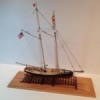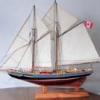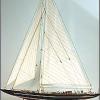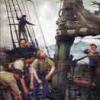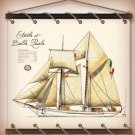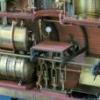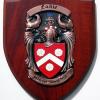MORE HANDBOOKS ARE ON THEIR WAY! We will let you know when they get here.
×
-
Posts
818 -
Joined
-
Last visited
Reputation Activity
-
 _SalD_ reacted to GLakie in US Brig Syren by _SalD_ – FINISHED - 3/16" scale
_SalD_ reacted to GLakie in US Brig Syren by _SalD_ – FINISHED - 3/16" scale
I hear that Sal. When I do my MS Connie, there'll be around 2,500 of 'em. Not really looking forward to it.
-
 _SalD_ got a reaction from canoe21 in US Brig Syren by _SalD_ – FINISHED - 3/16" scale
_SalD_ got a reaction from canoe21 in US Brig Syren by _SalD_ – FINISHED - 3/16" scale
Chapter 8 – coppering the hull
Prior to coppering the hull I need to make the stamps for the simulated nail heads in the copper plates. I will be using the nail pattern that Chuck shows in the instructions for the port and starboard plates and after studying Dirk’s (Dubz) build I will be making two additional stamps for the port and starboard dressing belts. The patterns were drawn to 3/16” scale using AutoCAD.
For the pins I used 26 gauge Lancets, bought at Wal-Mart, as mentioned in Richard’s (rtropp) and Thomas’s (Gahm) builds. I went with the thicker 26 gauge lancets and not the 30 gauge as Thomas used because I wasn’t showing as many nails he did. Extracting the needle from the plastic holder proved to be a challenge and what I finally did was; using my propane torch I heated the metal tip thus softening the plastic around the needle so it could be pulled out easier. Disclaimer: If you use this technique please be aware that the plastic does burn so use caution and have a cup of water on hand to place the plastic holder in.
I used some scrap poplar to make the stamp and cut it to the dimensions shown in the instructions. I glued the nail pattern on it as a guide and then I got to use the Christmas present from the Admiral (Proxxon drill press with compound table).
After drilling all the holes I inserted the pins and glued them in. Prior to inserting them I did cut about a ¼” off the needles (sharp end) so they wouldn’t stick out so much. One modification I made to the stamp was to attach an X-Acto chisel blade to one end of the stamp at the same height as the pins. I believe it’s a #17 blade and it fit the ¼” wide stamp perfectly. I attached the blade to mark the copper where I would need to make the cut for the individual plates, I found however that by applying just the right amount of force the blade will cut the copper but not the paper backing. I also made the opening in the jig a 1/16” larger to account for the blade thickness.
-
 _SalD_ got a reaction from jdbradford in US Brig Syren by _SalD_ – FINISHED - 3/16" scale
_SalD_ got a reaction from jdbradford in US Brig Syren by _SalD_ – FINISHED - 3/16" scale
Chapter 8 – coppering the hull
Prior to coppering the hull I need to make the stamps for the simulated nail heads in the copper plates. I will be using the nail pattern that Chuck shows in the instructions for the port and starboard plates and after studying Dirk’s (Dubz) build I will be making two additional stamps for the port and starboard dressing belts. The patterns were drawn to 3/16” scale using AutoCAD.
For the pins I used 26 gauge Lancets, bought at Wal-Mart, as mentioned in Richard’s (rtropp) and Thomas’s (Gahm) builds. I went with the thicker 26 gauge lancets and not the 30 gauge as Thomas used because I wasn’t showing as many nails he did. Extracting the needle from the plastic holder proved to be a challenge and what I finally did was; using my propane torch I heated the metal tip thus softening the plastic around the needle so it could be pulled out easier. Disclaimer: If you use this technique please be aware that the plastic does burn so use caution and have a cup of water on hand to place the plastic holder in.
I used some scrap poplar to make the stamp and cut it to the dimensions shown in the instructions. I glued the nail pattern on it as a guide and then I got to use the Christmas present from the Admiral (Proxxon drill press with compound table).
After drilling all the holes I inserted the pins and glued them in. Prior to inserting them I did cut about a ¼” off the needles (sharp end) so they wouldn’t stick out so much. One modification I made to the stamp was to attach an X-Acto chisel blade to one end of the stamp at the same height as the pins. I believe it’s a #17 blade and it fit the ¼” wide stamp perfectly. I attached the blade to mark the copper where I would need to make the cut for the individual plates, I found however that by applying just the right amount of force the blade will cut the copper but not the paper backing. I also made the opening in the jig a 1/16” larger to account for the blade thickness.
-
 _SalD_ got a reaction from Foultide in US Brig Syren by _SalD_ – FINISHED - 3/16" scale
_SalD_ got a reaction from Foultide in US Brig Syren by _SalD_ – FINISHED - 3/16" scale
Chapter 8 – coppering the hull
Prior to coppering the hull I need to make the stamps for the simulated nail heads in the copper plates. I will be using the nail pattern that Chuck shows in the instructions for the port and starboard plates and after studying Dirk’s (Dubz) build I will be making two additional stamps for the port and starboard dressing belts. The patterns were drawn to 3/16” scale using AutoCAD.
For the pins I used 26 gauge Lancets, bought at Wal-Mart, as mentioned in Richard’s (rtropp) and Thomas’s (Gahm) builds. I went with the thicker 26 gauge lancets and not the 30 gauge as Thomas used because I wasn’t showing as many nails he did. Extracting the needle from the plastic holder proved to be a challenge and what I finally did was; using my propane torch I heated the metal tip thus softening the plastic around the needle so it could be pulled out easier. Disclaimer: If you use this technique please be aware that the plastic does burn so use caution and have a cup of water on hand to place the plastic holder in.
I used some scrap poplar to make the stamp and cut it to the dimensions shown in the instructions. I glued the nail pattern on it as a guide and then I got to use the Christmas present from the Admiral (Proxxon drill press with compound table).
After drilling all the holes I inserted the pins and glued them in. Prior to inserting them I did cut about a ¼” off the needles (sharp end) so they wouldn’t stick out so much. One modification I made to the stamp was to attach an X-Acto chisel blade to one end of the stamp at the same height as the pins. I believe it’s a #17 blade and it fit the ¼” wide stamp perfectly. I attached the blade to mark the copper where I would need to make the cut for the individual plates, I found however that by applying just the right amount of force the blade will cut the copper but not the paper backing. I also made the opening in the jig a 1/16” larger to account for the blade thickness.
-
 _SalD_ got a reaction from tarbrush in US Brig Syren by _SalD_ – FINISHED - 3/16" scale
_SalD_ got a reaction from tarbrush in US Brig Syren by _SalD_ – FINISHED - 3/16" scale
Chapter 8 – coppering the hull
Prior to coppering the hull I need to make the stamps for the simulated nail heads in the copper plates. I will be using the nail pattern that Chuck shows in the instructions for the port and starboard plates and after studying Dirk’s (Dubz) build I will be making two additional stamps for the port and starboard dressing belts. The patterns were drawn to 3/16” scale using AutoCAD.
For the pins I used 26 gauge Lancets, bought at Wal-Mart, as mentioned in Richard’s (rtropp) and Thomas’s (Gahm) builds. I went with the thicker 26 gauge lancets and not the 30 gauge as Thomas used because I wasn’t showing as many nails he did. Extracting the needle from the plastic holder proved to be a challenge and what I finally did was; using my propane torch I heated the metal tip thus softening the plastic around the needle so it could be pulled out easier. Disclaimer: If you use this technique please be aware that the plastic does burn so use caution and have a cup of water on hand to place the plastic holder in.
I used some scrap poplar to make the stamp and cut it to the dimensions shown in the instructions. I glued the nail pattern on it as a guide and then I got to use the Christmas present from the Admiral (Proxxon drill press with compound table).
After drilling all the holes I inserted the pins and glued them in. Prior to inserting them I did cut about a ¼” off the needles (sharp end) so they wouldn’t stick out so much. One modification I made to the stamp was to attach an X-Acto chisel blade to one end of the stamp at the same height as the pins. I believe it’s a #17 blade and it fit the ¼” wide stamp perfectly. I attached the blade to mark the copper where I would need to make the cut for the individual plates, I found however that by applying just the right amount of force the blade will cut the copper but not the paper backing. I also made the opening in the jig a 1/16” larger to account for the blade thickness.
-
 _SalD_ got a reaction from Ol' Pine Tar in US Brig Syren by _SalD_ – FINISHED - 3/16" scale
_SalD_ got a reaction from Ol' Pine Tar in US Brig Syren by _SalD_ – FINISHED - 3/16" scale
Chapter 8 – coppering the hull
Prior to coppering the hull I need to make the stamps for the simulated nail heads in the copper plates. I will be using the nail pattern that Chuck shows in the instructions for the port and starboard plates and after studying Dirk’s (Dubz) build I will be making two additional stamps for the port and starboard dressing belts. The patterns were drawn to 3/16” scale using AutoCAD.
For the pins I used 26 gauge Lancets, bought at Wal-Mart, as mentioned in Richard’s (rtropp) and Thomas’s (Gahm) builds. I went with the thicker 26 gauge lancets and not the 30 gauge as Thomas used because I wasn’t showing as many nails he did. Extracting the needle from the plastic holder proved to be a challenge and what I finally did was; using my propane torch I heated the metal tip thus softening the plastic around the needle so it could be pulled out easier. Disclaimer: If you use this technique please be aware that the plastic does burn so use caution and have a cup of water on hand to place the plastic holder in.
I used some scrap poplar to make the stamp and cut it to the dimensions shown in the instructions. I glued the nail pattern on it as a guide and then I got to use the Christmas present from the Admiral (Proxxon drill press with compound table).
After drilling all the holes I inserted the pins and glued them in. Prior to inserting them I did cut about a ¼” off the needles (sharp end) so they wouldn’t stick out so much. One modification I made to the stamp was to attach an X-Acto chisel blade to one end of the stamp at the same height as the pins. I believe it’s a #17 blade and it fit the ¼” wide stamp perfectly. I attached the blade to mark the copper where I would need to make the cut for the individual plates, I found however that by applying just the right amount of force the blade will cut the copper but not the paper backing. I also made the opening in the jig a 1/16” larger to account for the blade thickness.
-
 _SalD_ got a reaction from WackoWolf in US Brig Syren by _SalD_ – FINISHED - 3/16" scale
_SalD_ got a reaction from WackoWolf in US Brig Syren by _SalD_ – FINISHED - 3/16" scale
Chapter 8 – coppering the hull
Prior to coppering the hull I need to make the stamps for the simulated nail heads in the copper plates. I will be using the nail pattern that Chuck shows in the instructions for the port and starboard plates and after studying Dirk’s (Dubz) build I will be making two additional stamps for the port and starboard dressing belts. The patterns were drawn to 3/16” scale using AutoCAD.
For the pins I used 26 gauge Lancets, bought at Wal-Mart, as mentioned in Richard’s (rtropp) and Thomas’s (Gahm) builds. I went with the thicker 26 gauge lancets and not the 30 gauge as Thomas used because I wasn’t showing as many nails he did. Extracting the needle from the plastic holder proved to be a challenge and what I finally did was; using my propane torch I heated the metal tip thus softening the plastic around the needle so it could be pulled out easier. Disclaimer: If you use this technique please be aware that the plastic does burn so use caution and have a cup of water on hand to place the plastic holder in.
I used some scrap poplar to make the stamp and cut it to the dimensions shown in the instructions. I glued the nail pattern on it as a guide and then I got to use the Christmas present from the Admiral (Proxxon drill press with compound table).
After drilling all the holes I inserted the pins and glued them in. Prior to inserting them I did cut about a ¼” off the needles (sharp end) so they wouldn’t stick out so much. One modification I made to the stamp was to attach an X-Acto chisel blade to one end of the stamp at the same height as the pins. I believe it’s a #17 blade and it fit the ¼” wide stamp perfectly. I attached the blade to mark the copper where I would need to make the cut for the individual plates, I found however that by applying just the right amount of force the blade will cut the copper but not the paper backing. I also made the opening in the jig a 1/16” larger to account for the blade thickness.
-
 _SalD_ got a reaction from Gahm in US Brig Syren by _SalD_ – FINISHED - 3/16" scale
_SalD_ got a reaction from Gahm in US Brig Syren by _SalD_ – FINISHED - 3/16" scale
Chapter 8 – coppering the hull
Prior to coppering the hull I need to make the stamps for the simulated nail heads in the copper plates. I will be using the nail pattern that Chuck shows in the instructions for the port and starboard plates and after studying Dirk’s (Dubz) build I will be making two additional stamps for the port and starboard dressing belts. The patterns were drawn to 3/16” scale using AutoCAD.
For the pins I used 26 gauge Lancets, bought at Wal-Mart, as mentioned in Richard’s (rtropp) and Thomas’s (Gahm) builds. I went with the thicker 26 gauge lancets and not the 30 gauge as Thomas used because I wasn’t showing as many nails he did. Extracting the needle from the plastic holder proved to be a challenge and what I finally did was; using my propane torch I heated the metal tip thus softening the plastic around the needle so it could be pulled out easier. Disclaimer: If you use this technique please be aware that the plastic does burn so use caution and have a cup of water on hand to place the plastic holder in.
I used some scrap poplar to make the stamp and cut it to the dimensions shown in the instructions. I glued the nail pattern on it as a guide and then I got to use the Christmas present from the Admiral (Proxxon drill press with compound table).
After drilling all the holes I inserted the pins and glued them in. Prior to inserting them I did cut about a ¼” off the needles (sharp end) so they wouldn’t stick out so much. One modification I made to the stamp was to attach an X-Acto chisel blade to one end of the stamp at the same height as the pins. I believe it’s a #17 blade and it fit the ¼” wide stamp perfectly. I attached the blade to mark the copper where I would need to make the cut for the individual plates, I found however that by applying just the right amount of force the blade will cut the copper but not the paper backing. I also made the opening in the jig a 1/16” larger to account for the blade thickness.
-
 _SalD_ got a reaction from GLakie in US Brig Syren by _SalD_ – FINISHED - 3/16" scale
_SalD_ got a reaction from GLakie in US Brig Syren by _SalD_ – FINISHED - 3/16" scale
Thanks George, now I just have to make a bazillion plates.
-
 _SalD_ reacted to thorn21g in USS ST LOUIS by thorn21g - 1:24 - POF - Civil War Ironclad - Gateway Model Shipcrafter's Guild
_SalD_ reacted to thorn21g in USS ST LOUIS by thorn21g - 1:24 - POF - Civil War Ironclad - Gateway Model Shipcrafter's Guild
Civil War Ironclad, USS St. Louis - !:24
Sequence of Assembly for USS St. Louis Model Rev C
Notes:
Rev A: This revision modifies Steps 5 thru 13 to permit direct use of the NPS plans to locate the structural elements yet allows installation of tempered hardboard sheets to add longitudinal stiffness to the lower hull structure.
Rev B: This revision adds Steps 14 thru 18 with details for constructing and installing the hurricane deck as a removable sub-assembly.
Rev 😄 This revision adds refinements to the sequence of assembly which were developed during model construction thus far.
1. Make a copy of sheets 3 & 4 of the "USS Cairo" National Park's Service plans at 1:24 scale and secure them to a sheet of 1/8 inch thick tempered hardboard.
2. Fabricate the three keels with scarf joints necessary to achieve about 4" longer than plan apparent length. Secure them directly on sheets 3 & 4 of the NPS hull floor plans with several 1/8" wood screws. (The keels will be trimmed to their final lengths in Steps 6 thru 9.
3. Fabricate all full and half frames up to the gun deck level chines using the three assembly jigs, locate them to the plans using small try-squares, and secure them to the keels with "Titebond III" wood glue and .052" diameter treenails in .055" holes. Place temporary wood support strips, which are the same thickness as the keels, under the lower frame floors at their outboard edges. (Do not glue or treenail the frames to these strips) Make a dozen or more wooden combs about 9" long by 1" wide by .25" thick which are dadoed to the "room and space" dimensions of the lower hull framing. Use these combs to temporarily locate and support the outboard ends of the frames as they are being secured to the keels. This is especially important for the aft half frames at the paddle wheel opening since they are only attached to one keel at this juncture. (By overlapping these 9" combs most of the hull structure can be made very rigid in preparation for installing the keelsons, deck clamps and other longitudinal structural members.)
4. Make the five keelsons & port and starboard gun deck clamps and secure them to all frames.
5. Attach about 6 temporary spreader beams, especially at the stern where the hull is split into two booms between the port & starboard gun deck clamps to maintain the lower hull shape.
6. Invert the partially completed hull structure and support it on jig locators to the inside of the hull floor timbers.
7. Make two longitudinal strips of 1/8-inch tempered hardboard approximately 4.5 inches wide which will fit snugly between the 3 keels and secure them to the lower surface of the frames with glue and treenails.
8. Add the cant frames, bevel the frames of the bow and stern to achieve a faired surface on the lower chine and install one or two rows of planking along the lower edge of the chine.
9. Make two additional strips of 1/8-inch tempered hardboard which abut the outer edges of the port and starboard keels and trim them to the outer surface of the lower chine planking. Secure them to the frames with glue and treenails.
10. Return the model to its upright position and install portions of ceiling, floor planking and longitudinal stanchions.
11. Frame and plank the waterway leading to the paddlewheel.
12. Add hull mounting provisions for the engines, paddlewheel and other machinery.
13. Add selected portions of the gun deck beams and planking which provide support for the armament while maintaining desired visibility to lower portions of the hull.
14. Based on further research of contemporary Civil War photographs we are convinced that unlike the flat decks shown on the NPS "USS Cairo" plans, the hurricane deck actually has a significant round-up (camber) of about 6.5-inches or .27-inches & a 15-foot arc at the 1:24 scale of our model. For accuracy this deck will be fabricated as a sub-assembly directly upon sheets 7 & 8 of the NPS plans and subsequently located over the lower hull structure and attached via the upper casement frames with removable pins thereby providing good internal hull access throughout the remaining model construction. The lower surfaces of the deck beams will remain flat since the distance between the gun deck planking and hurricane deck beams is over 7-feet and therefore an additional 6.5-inches on centerline would have been an unnecessary expense.
15. Make the 43 hurricane deck beams (carlines) from hard maple stock with identical the round-up (camber) formed into their upper surfaces using a special sanding fixture for the 15-foot radius mounted on a 4-inch table equipped vertical belt sander.
16. Construct the hurricane deck consisting of the port and starboard carline clamps (deck clamps), deck beams, and additional longitudinal framing members for the stacks, skylight, and wheelhouse. The present plan is to apply deck planking to at least one side (port or starboard) and additional selected planking to be determined later.
17. Locate the hurricane deck sub-assembly above the lower hull assembly on temporary supports or internal hull bulkheads while installing upper casement frames which are permanently fixed to the chine knuckles and pinned to the hurricane deck beams.
18. Frame in the gun ports and apply selected exterior planking to the upper casements. Temporarily un-pin and remove the hurricane deck to provide access for installing selected upper casement ceiling.
19. With the hurricane deck removed, continue with installation of the bulkheads and partitions around the wheelhouse, cabins and boilers and any other features on the gun deck.
Method used to Construct the Lower Hull Frames (Rev A).doc
Snap26.bmp
Snap27.bmp
Snap28.bmp
Snap29.bmp
Jig #3 Set-Up and Procedure for Use 26 Mar 2015.doc
Method used to Construct the Lower Hull Frames (Rev A).doc
Snap1.bmp
Snap2.bmp
Snap3.bmp
Snap5.bmp
Snap6.bmp
Snap7.bmp
-
 _SalD_ got a reaction from rtropp in US Brig Syren by _SalD_ – FINISHED - 3/16" scale
_SalD_ got a reaction from rtropp in US Brig Syren by _SalD_ – FINISHED - 3/16" scale
Chapter 8 – coppering the hull
Prior to coppering the hull I need to make the stamps for the simulated nail heads in the copper plates. I will be using the nail pattern that Chuck shows in the instructions for the port and starboard plates and after studying Dirk’s (Dubz) build I will be making two additional stamps for the port and starboard dressing belts. The patterns were drawn to 3/16” scale using AutoCAD.
For the pins I used 26 gauge Lancets, bought at Wal-Mart, as mentioned in Richard’s (rtropp) and Thomas’s (Gahm) builds. I went with the thicker 26 gauge lancets and not the 30 gauge as Thomas used because I wasn’t showing as many nails he did. Extracting the needle from the plastic holder proved to be a challenge and what I finally did was; using my propane torch I heated the metal tip thus softening the plastic around the needle so it could be pulled out easier. Disclaimer: If you use this technique please be aware that the plastic does burn so use caution and have a cup of water on hand to place the plastic holder in.
I used some scrap poplar to make the stamp and cut it to the dimensions shown in the instructions. I glued the nail pattern on it as a guide and then I got to use the Christmas present from the Admiral (Proxxon drill press with compound table).
After drilling all the holes I inserted the pins and glued them in. Prior to inserting them I did cut about a ¼” off the needles (sharp end) so they wouldn’t stick out so much. One modification I made to the stamp was to attach an X-Acto chisel blade to one end of the stamp at the same height as the pins. I believe it’s a #17 blade and it fit the ¼” wide stamp perfectly. I attached the blade to mark the copper where I would need to make the cut for the individual plates, I found however that by applying just the right amount of force the blade will cut the copper but not the paper backing. I also made the opening in the jig a 1/16” larger to account for the blade thickness.
-
 _SalD_ reacted to popeye the sailor in Andrea Gail by popeye the Sailor - FINISHED - 1:20 scale
_SalD_ reacted to popeye the sailor in Andrea Gail by popeye the Sailor - FINISHED - 1:20 scale
I did get a little done on Friday.........added the supports to the base of the vent
this is the makings of the pulley that will be added for the trawl rig. there is only one.....but I might make the other one too.
posts were cemented into the bottom of the lights
this is the finished pulley
a base was added to the lights......may even aide in locating them
the pulleys were fastened to the ends of the birds. I took these pictures for a friend of mine at work
-
 _SalD_ reacted to augie in USF Confederacy by Augie & Moonbug - FINISHED - Model Shipways - 1:64
_SalD_ reacted to augie in USF Confederacy by Augie & Moonbug - FINISHED - Model Shipways - 1:64
Have finally made some headway on getting the rails installed. I'm working from stern to stem so we began with the quarterdeck and stern rails:
All of the rails are 3/16 x 1/16 boxwood and are faced on the hull side with 1/16 x 1/16 basswood molding which was beaded using a scraper. The camera is simply not picking this up due to the black color but it's there. It will be more distinct on the forward railings where the molding will be natural.
Then stern rail was a bit of a challenge as it's a compound curve which was made by a combination of lateral and edge bending. It would definitely be easier to fabricate from wider stock (thereby eliminating the edge bend). But I love a challenge and needed more wood in my scrap box .
Will be moving forward now as Confed competes with the great outdoors and it's associated activities.
-
 _SalD_ reacted to GuntherMT in Indian Girl Canoe by GuntherMT - FINISHED - Midwest Products - Scale 1:12 - SMALL
_SalD_ reacted to GuntherMT in Indian Girl Canoe by GuntherMT - FINISHED - Midwest Products - Scale 1:12 - SMALL
Got back to the canoe the other day, and roughed in the other end above the gunwale.
And then finished it and sanded the entire thing - 120 -> 220 -> 320
Then after some experimenting on scraps, I took the first big plunge towards my eventual finish plans.
I chose to stain it prior to putting the ribs in (which are also stained, but no pictures) in order to alleviate worry about glue around the edges of the ribs showing up as glaring spots where the stain didn't go. I think it will be very difficult to do any good clean-up around the ribs internally after they are placed. I guess I'll find out later if that was a huge mistake, as the one thing I forgot to test was the effect of soaking on a stained piece of wood, and I think the ribs will have to be soaked in order to make the crazy bends inside the canoe. I will try doing it with jigs and heat first (on scrap), but I really don't think I'll be able to get away without soaking for this.
-
 _SalD_ reacted to GuntherMT in Indian Girl Canoe by GuntherMT - FINISHED - Midwest Products - Scale 1:12 - SMALL
_SalD_ reacted to GuntherMT in Indian Girl Canoe by GuntherMT - FINISHED - Midwest Products - Scale 1:12 - SMALL
Soaking didn't seem to do much to the stain, possibly lightened it a bit, but no splotching or bleeding. Even after soaking for the entire work-day, the ribs were quite difficult to get bent into place without breaking, and I really couldn't figure out a good way to clamp them. Given that they were being placed 'wet', I gave up on using my white PVA, as it would have required I hold each rib in place for a good 30 minutes or more, and this is supposed to be a quick 'side project', so I gave in and used CA to place the ribs. I'll have a good bit of inside cleanup to do in order to get rid of the CA shine and fogging, but should still be much less time than individually clamping the ribs long enough to set with PVA.
It's not perfect by any stretch of the imagination, as I did all the placement by eye-ball, instead of carefully measuring and marking where each end should be to keep them all perfectly perpendicular and straight. It came out well enough I think.
-
 _SalD_ reacted to augie in US Brig Syren by rameyke - Model Shipways
_SalD_ reacted to augie in US Brig Syren by rameyke - Model Shipways
You have it sitting nicely in the rabbet and a great looking run of plank. I'm smiling.
-
 _SalD_ reacted to rameyke in US Brig Syren by rameyke - Model Shipways
_SalD_ reacted to rameyke in US Brig Syren by rameyke - Model Shipways
Ha! Sal was partially correct about the first row of planks above the wale. I could not tell by the pictures, but as I was pulling the planking off, I noticed that the first piece of planking above the wale at the bow was in fact 5/32 x 1/16 on both sides. The rest of the row was the correct size. I must have grabbed the wrong width wood when I was bending those pieces.
Well, my first attempt at planking has been pulled. After cleaning up the old glue and doing a little work on the rabbet, I am happy to say that i reinstalled the upper wale. I have a nice clean run. No lateral bends and it meets up at the keel in the bow very nicely.
Augie, your advice on redoing the planks and pre-trimming the piece that meets the bow was used and appreciated.
Sal, thank you for the diagram. Sanding the back of the corner where the plank hits the rabbet worked out nicely.
Tonight I will start planking above the wale again.
I realized that the upper wale would be covered by another layer, so I went ahead and used the kit basswood for this piece. Just in case I needed to tear it off again
Much nicer run of the plank. No lateral bend like last time.
-
 _SalD_ got a reaction from cg451 in US Brig Syren by rameyke - Model Shipways
_SalD_ got a reaction from cg451 in US Brig Syren by rameyke - Model Shipways
Ken,
1. did you use the temporary batten to mark the position of the first wale before gluing it to the hull? It will show you if you need to make any adjustments from the prescribed marks on the bulkheads.
2. for the bow end of the plank I chamfered the back edge a little to make it fit better into the rabbet. see sketch below.
Also, maybe it's just my old eyes but, it appears from the pictures that the plank above the first wale is the same width, it should be smaller (1/8" wide).
-
 _SalD_ reacted to popeye the sailor in Andrea Gail by popeye the Sailor - FINISHED - 1:20 scale
_SalD_ reacted to popeye the sailor in Andrea Gail by popeye the Sailor - FINISHED - 1:20 scale
I really want to thank all of you fine folks again for following along and being so supportive. back in the day, before the internet, ya built a model......enjoyed the experience and then it would languish on a shelf until the parts fell off. the internet changed a lot for the hobby.....it opened that closed up space where we build, and allows a vast audience to view your work. it's taken it to another level! it's also allowed us access to information, which helps us to become better modelers. this site, and you fine folk, make it a win / win for us all
after my last post, I went back at it, and made more progress. those two pieces of dowel you saw earlier......well, in looking at the instructions, I found that I only needed one of them. I began to make the parts for the life raft locker.
what I had done to the light boxes earlier had dried, so I did a bit more paint work on them.
the pilot house is closed now........the roof is cemented in place. with the dry fits, came the conclusion that interior views are restricted to what you see. it'll speed things up.......there are bigger fish to fry later on. I still have the Boulogne......with her larger windows {I can even do wipers}
time was juggled between the life raft locker and the funnel addition for the roof. the locker was assembled and paint work had started.
the funnel addition was bland.......nothing went in the cavity in the top of it. I made it a bit wider too, thinking that something did. so far, I added a vent tube.....I'll think of something else to utilize the space. there is another pipe {the actual exhaust stack, I believe}, that runs up the side of it. brackets were added to it for support.
the stanchion is finally in place. the pulley was added and received it's final touch up of paint. it will be rigged later when dry.
this may look like the start of the next wave of parts to be added to the model.....but no. there are a few more parts that need to be made......the roof is the focal point now. the funnel addition is cemented in place.......I can add to it there, just as well as on the table.
the nav lights are next.......they are done after the window maker was dry, a dab of Signal Red and Emerald Green inside the lenses, was enough to finish them. the boxes got the final paint and touch ups.
the focus now is to get the roof fitted out and do something I have been putting off.......more ladders
-
 _SalD_ got a reaction from CharlieZardoz in US Brig Syren by _SalD_ – FINISHED - 3/16" scale
_SalD_ got a reaction from CharlieZardoz in US Brig Syren by _SalD_ – FINISHED - 3/16" scale
I was a little disappointed in the way I finished the deck and I learned what not to do next time. I drilled all the holes for the treenails prior to staining the deck which in hind sight I don’t think was a good idea. Prior to staining the deck I stained a test strip with holes in it similar to the deck and found that the stain was bleeding into the holes making a dark ring at each hole. To avoid this I filled all the holes with wood filler before staining. There was no bleeding into the holes but the stain was a little blotchy (yes Augie I tried pre-stain this time). I believe it was from not sanding the deck enough to remove all the wood filler that was on the surface. I was a little reluctant to sand too much in fear of sanding through the deck plank but again in hind sight there was plenty of material left to sand.
For the treenails I decided to show only the treenails located along the deck beams where I had a butt joint and not at every beam between the bulkheads. I thought it would be too much, not to mention I didn’t want to drill all those holes. The only problem was that after I filled them with wood filler and stained the deck the treenails didn’t show up too well. I may redo them.
For the waterway I tried a few different procedures to make the triangular chamfer strip from the 1/16” square stock. There is probably a real simple way of doing this but what I came up with was; first I cut a V-groove in a piece of scrap pine using a V gouge, making the depth of the groove slightly less than the finished shape of the waterway. Next I taped two erasing shields on either side of the groove to avoid sanding into the pine. The shields are 0.1 mm thick. Then I laid the wood strip in the groove and removed the top half using my dremel’s drum sanding attachment. What was left was a nice 1/16” X 1/16” chamfer strip.
-
 _SalD_ reacted to popeye the sailor in Andrea Gail by popeye the Sailor - FINISHED - 1:20 scale
_SalD_ reacted to popeye the sailor in Andrea Gail by popeye the Sailor - FINISHED - 1:20 scale
another aspect that I'll need to get on there, to gauge the decal, are the nav lights. I got this idea during the drive to and from the garage yesterday. I can make the boxes alright......but it's the lights themselves that I had to ponder over. I dove in head first
I saw a tubing cutter at the hobby store during my last visit. it would make my task a lot easier......but I didn't buy it. I have two of them at home.......I use them to cut tubing for brake lines and other such stuff in automotive repair. I cleaned this one up and made sure the rollers and blade were in good shape.
taking a piece of tubing {of suitable size} and locking it in the vise, I made two cuts and removed the center. then with a flat file, I squared up the opening. you might be able to see where I marked it when it's time to cut the part off.
the boxes were roughed out......I'll give them time to dry a bit.
I cut these two pieces of dowel........they are for something else
at this time I did some of the trim work to the boxes.
using a pair of scissors that I use for this task, I cut a few circles from some really thin brass flat stock.
the second light was created.......now they will be cut from the piece of tubing
the circles are going to be molded to form the top of the lights......I hope your watching this Piet.....I'm going to try and make you smile once they are molded, they will be soldered on the light bodies.
first, I took a drill and made a pit for the tops to fit in.
then, cutting a pie shaped piece out of the circle, it was fashioned into a dome, and placed into the impression.
the idea worked great until this point........kinda went down hill from here. to hold it in place was a pain, then to dip the tip of the iron in flux, get a drop of solder on the iron, and apply it to the light, was another.......but I managed to get the job done. no virgin ears in this house....I can tell you that!
I will use rough sandpaper to clean it up....I don't want to use a file......liable to ruin it. it cleaned up fairly well......I went over it with some finer paper. they'll be painted gloss white when I am done.
-
 _SalD_ got a reaction from canoe21 in US Brig Syren by _SalD_ – FINISHED - 3/16" scale
_SalD_ got a reaction from canoe21 in US Brig Syren by _SalD_ – FINISHED - 3/16" scale
I was a little disappointed in the way I finished the deck and I learned what not to do next time. I drilled all the holes for the treenails prior to staining the deck which in hind sight I don’t think was a good idea. Prior to staining the deck I stained a test strip with holes in it similar to the deck and found that the stain was bleeding into the holes making a dark ring at each hole. To avoid this I filled all the holes with wood filler before staining. There was no bleeding into the holes but the stain was a little blotchy (yes Augie I tried pre-stain this time). I believe it was from not sanding the deck enough to remove all the wood filler that was on the surface. I was a little reluctant to sand too much in fear of sanding through the deck plank but again in hind sight there was plenty of material left to sand.
For the treenails I decided to show only the treenails located along the deck beams where I had a butt joint and not at every beam between the bulkheads. I thought it would be too much, not to mention I didn’t want to drill all those holes. The only problem was that after I filled them with wood filler and stained the deck the treenails didn’t show up too well. I may redo them.
For the waterway I tried a few different procedures to make the triangular chamfer strip from the 1/16” square stock. There is probably a real simple way of doing this but what I came up with was; first I cut a V-groove in a piece of scrap pine using a V gouge, making the depth of the groove slightly less than the finished shape of the waterway. Next I taped two erasing shields on either side of the groove to avoid sanding into the pine. The shields are 0.1 mm thick. Then I laid the wood strip in the groove and removed the top half using my dremel’s drum sanding attachment. What was left was a nice 1/16” X 1/16” chamfer strip.
-
 _SalD_ got a reaction from GLakie in US Brig Syren by _SalD_ – FINISHED - 3/16" scale
_SalD_ got a reaction from GLakie in US Brig Syren by _SalD_ – FINISHED - 3/16" scale
Thomas, I used a 50 - 50 mixture of MinWax natural and golden oak. I didn't want the deck too dark.
-
 _SalD_ got a reaction from jdbradford in US Brig Syren by _SalD_ – FINISHED - 3/16" scale
_SalD_ got a reaction from jdbradford in US Brig Syren by _SalD_ – FINISHED - 3/16" scale
I was a little disappointed in the way I finished the deck and I learned what not to do next time. I drilled all the holes for the treenails prior to staining the deck which in hind sight I don’t think was a good idea. Prior to staining the deck I stained a test strip with holes in it similar to the deck and found that the stain was bleeding into the holes making a dark ring at each hole. To avoid this I filled all the holes with wood filler before staining. There was no bleeding into the holes but the stain was a little blotchy (yes Augie I tried pre-stain this time). I believe it was from not sanding the deck enough to remove all the wood filler that was on the surface. I was a little reluctant to sand too much in fear of sanding through the deck plank but again in hind sight there was plenty of material left to sand.
For the treenails I decided to show only the treenails located along the deck beams where I had a butt joint and not at every beam between the bulkheads. I thought it would be too much, not to mention I didn’t want to drill all those holes. The only problem was that after I filled them with wood filler and stained the deck the treenails didn’t show up too well. I may redo them.
For the waterway I tried a few different procedures to make the triangular chamfer strip from the 1/16” square stock. There is probably a real simple way of doing this but what I came up with was; first I cut a V-groove in a piece of scrap pine using a V gouge, making the depth of the groove slightly less than the finished shape of the waterway. Next I taped two erasing shields on either side of the groove to avoid sanding into the pine. The shields are 0.1 mm thick. Then I laid the wood strip in the groove and removed the top half using my dremel’s drum sanding attachment. What was left was a nice 1/16” X 1/16” chamfer strip.
-
 _SalD_ got a reaction from tarbrush in US Brig Syren by _SalD_ – FINISHED - 3/16" scale
_SalD_ got a reaction from tarbrush in US Brig Syren by _SalD_ – FINISHED - 3/16" scale
I was a little disappointed in the way I finished the deck and I learned what not to do next time. I drilled all the holes for the treenails prior to staining the deck which in hind sight I don’t think was a good idea. Prior to staining the deck I stained a test strip with holes in it similar to the deck and found that the stain was bleeding into the holes making a dark ring at each hole. To avoid this I filled all the holes with wood filler before staining. There was no bleeding into the holes but the stain was a little blotchy (yes Augie I tried pre-stain this time). I believe it was from not sanding the deck enough to remove all the wood filler that was on the surface. I was a little reluctant to sand too much in fear of sanding through the deck plank but again in hind sight there was plenty of material left to sand.
For the treenails I decided to show only the treenails located along the deck beams where I had a butt joint and not at every beam between the bulkheads. I thought it would be too much, not to mention I didn’t want to drill all those holes. The only problem was that after I filled them with wood filler and stained the deck the treenails didn’t show up too well. I may redo them.
For the waterway I tried a few different procedures to make the triangular chamfer strip from the 1/16” square stock. There is probably a real simple way of doing this but what I came up with was; first I cut a V-groove in a piece of scrap pine using a V gouge, making the depth of the groove slightly less than the finished shape of the waterway. Next I taped two erasing shields on either side of the groove to avoid sanding into the pine. The shields are 0.1 mm thick. Then I laid the wood strip in the groove and removed the top half using my dremel’s drum sanding attachment. What was left was a nice 1/16” X 1/16” chamfer strip.


